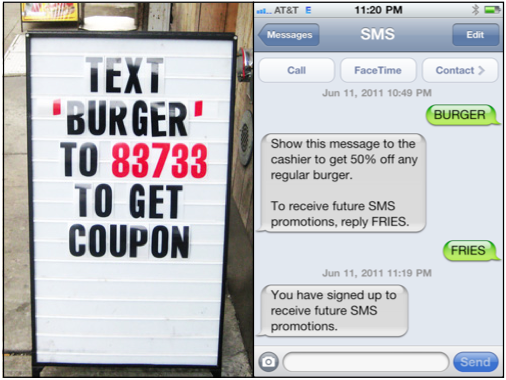Is SMS Marketing Too Invasive?
Mobile and SMS marketing have been around for awhile now, so obviously marketers have been learning how to implement them more efficiently into their overall marketing campaign. However, it still seems to be unclear whether SMS marketing is too invasive, or not invasive enough. Looking at companies who have enacted SMS campaigns, it is apparent that some of them are sending way too many text messages to their subscribers, while others are clearly not sending enough. SMS marketing can be your most effective marketing tool, but marketers are going to have to learn how to find a happy medium between too much, and not enough.

SMS marketing has always been a great way for marketers, companies, and agencies to create ongoing dialogue with their end users. However, the industry is still learning how to use it more efficiently. “The SMS industry has come a long way in diminishing spam and improving relevancy,” said Shuli Lowy, Marketing Director at Ping Mobile. “However, we all still bare the scars of a dark past time when unsolicited and intrusive text messages were rampant in the kingdom of mobile.”
This has obviously changed over the years. Mobile and SMS marketers now need to follow strict guidelines when it comes to the opt-in and opt-out process. “Marketers engaging in SMS marketing now have to begin their consumer dialogue with clear instructions on how to opt out,” continued Lowy. “As well as information about message charges, frequency of messages, and information on how to get further assistance. Opt-in consent that is received via non-mobile portals need to be confirmed via mobile and premium SMS campaigns need to exercise a double opt-in process.”
Since there is a clearly defined opt-in process, end users can choose which brands and companies they want to receive messages from. Best practices say for businesses to text their subscribers around 3-4 messages a month. Many companies, however, are exceeding this rate or not even meeting it. Too many messages will only annoy and irritate your end users, but not enough messages will cause your end users to forget about you, completely defeating the entire point of an SMS campaign.
“Marketers must remember that the goal is not to dangle a piece of candy in front of consumers and then trap them into a mobile relationship prison,” Ms. Lowy said. “Instead the goal is to invite consumers in to engage with your brand through mobile and make sure to offer compelling content to keep the consumer interested and strengthen that relationship, but always leave the door open should they wish to leave.”
Lowy also said that it is important to exercise a double opt-in process for normal campaigns. This isn’t required, but it is highly recommended. She also recommended closing messages with a restatement of how to opt-out.

“The second most important strategy tip to create a powerful SMS experience is to ensure that your text messages don’t repeat information that consumers already know,” she continued. “Do not send consumers the same content via email, social media, and mobile. Your marketing channels should work together and weave into a multi-faceted brand relationship.”
Since 97% of all SMS messages are read within minutes of being received, we are starting to see smaller businesses adopt SMS into their marketing campaigns. “SMS marketing has already been used by large brands for years,” Lowy said. “Those brands are already moving on to more complex forms of mobile marketing which are propelling the smartphone era. However, small businesses are still very new to mobile and SMS is the most sensible place for them to dip their toes in the mobile marketing pool. Small B2C facing businesses have a lot to gain from SMS and we will see them starting to adopt it as a marketing tool in 2013.”
The general consensus among marketers is to take into account several factors when deciding when and when not to text their subscribers. Time, location, and interaction all need to be considered before sending messages, and agencies need to think about when and where their subscribers will be when they receive their messages. Determining whether or not you are sending enough or not enough is tricky, but keeping these factors in mind can help make that determination much easier.
Alex Campbell, Co-founder and Chief Innovation officer at Vibes, commented, “People text with their friends, and if you as a marketer are let into that circle, you’ve really earned someone’s trust. Once you build trusting relationships, that’s a powerful – and winning – connection for you and your customer, which often leads to brand loyalty.”
Remember that SMS messaging is a real-time marketing channel that works most efficiently with ongoing messaging. However, if you are doing it too much, or even worse, not providing value to your subscribers with your messages, you are fighting a losing battle. Keep your messages to 3-4 a month, only going over if you feel you have real value to offer the customer. Include multimedia in your texts, brand logos, product images, or even how-to videos. All of these have been proven to increase returns on SMS marketing. You also want to promote your SMS campaign anywhere and everywhere. SMS marketing success increases as your database gets bigger. The more people that are receiving your texts, the higher chance you have of one of those subscribers coming to you for business.

SMS marketing can be your best and most efficient tool if you use it right. The funny thing is that it’s not that hard. Companies who use SMS inefficiently simply did not educate themselves properly or didn’t even take the time to educate themselves. Follow SMS marketing’s best practices, and what you’ve read in this article, and you are sure to have a very strong and effective SMS campaign.









Leave a Reply
Want to join the discussion?Feel free to contribute!